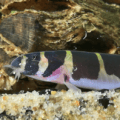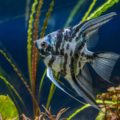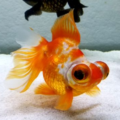Are you looking to add a popular aquarium fish to your community tank but don’t know which one of the many varieties to choose? Let me introduce you to the beautiful freshwater Angelfish, scientific name Pterophyllum, which is also surprisingly low-maintenance.

Discover the Diverse World of Freshwater Angelfish
This unique-shaped fish is native to the Amazon Basin of South America but has stolen the hearts of fishkeeping enthusiasts worldwide.
If you’re bothered about having different types of fish in one tank, don’t worry; there are enough Angelfish varieties to give you a diverse community. Here’s a look at 15 types of Angelfish you can add to your tank today!
Quick Sidenote: Do you want to watch this article instead of reading it? Checkout the highlight video below from our YouTube Channel (Or read the more detailed article below), be sure to Subscribe For More Great Fishkeeping Content:
Altum Angelfish

This tall Angelfish species is popular for its obviously longer body and higher dorsal fin. They’re typically silver or gold with black stripes, but when bred in captivity, Altum angelfish develop different colors.
Because of their height, their tank requirements are different from basic angelfish species. You must get a tall tank that holds at least 55 gallons of water for one Altum Angelfish and an extra 15 gallons per extra fish you add.
More Altum angelfish care tips include feeding them twice daily in little portions of flakes and pellets and pairing them with peaceful fish for stress-free cohabitation.
Its ideal habitat has a 78 – 82℉ temperature, 5.8 – 7 pH level, 3 – 10 dGH hardness, with soft substrates and live plants.
Silver Angelfish

If you want a beginner-friendly Angelfish, this variant is for you. The Silver angelfish, with its light silver and black stripes, is one of the more popular types of this unique fish.
They don’t require much when it comes to caring except for a lower temperature of 76-80℉.
They’re peaceful tank mates that thrive with other angelfish variants. You can pair your Silver Angelfish with large tetras, large rasboras, corydoras, and Plecos. Don’t pair them with small, aggressive, or fast-swimming fish.
Zebra Angelfish

You can’t miss the striking black and white stripes of the Zebra angelfish, even in a community tank. Despite having one of the most distinct coloration of all angelfish types, this species isn’t fussy or stressful to maintain.
This striped freshwater fish is an omnivore that eats plants and live food. The better its diet, the more pronounced its Zebra stripes appear.
Their fins are sensitive, so only use decor and substrate with smooth and soft textures. Also, get a tall tank that reaches up to about 18 inches to allow your Zebra angelfish to swim comfortably upwards and downwards.
Black Lace Angelfish

Wonder where the Black Lace angelfish got its name? All you need to do is look at its skin, and you will understand. It has dark-colored scales beautified with lacy patterns, which makes it an elegant aquarium fish.
While the dark-colored lacy scales make this Angelfish outstanding, it also makes it prone to illnesses caused by poor water quality. So, you must add a good filtration system to your tank if it has a Black Lace angelfish.
Koi Angelfish

If you want a colorful angelfish to grab guests’ attention at first glance, then add the Koi angelfish to your aquarium. Its white scales, splattered with orange, red, and black patches, are reminiscent of the Japanese Koi fish, and that’s not the best part.
You can have multiple Koi angelfish in one tank with different color varieties. Isn’t that cool?
To maintain vibrant scales, keep the water parameters stable and provide good lighting. Also, feed them food rich in protein and color-enhancing ingredients like Spirulina, Carotenoids, and Astaxanthin.
Marble Angelfish

Looking for more patterned freshwater fish? Here’s the Marble angelfish to your rescue. This species has marbled scales in different shades of black, white, or gray that make it look like a stone.
Their multicolored tone makes the marble angelfish visually engaging. You’ll find yourself attracted to their scales and graceful swimming.
For this angelfish’s care, water quality should be your priority because of its sensitive skin. Also, note that they can get territorial and love swimming from up to down, so a tall tank is the most suitable design for them.
Blushing Angelfish

This variant is a cutesy, pretty, soft pink or pale red angelfish, hence the name Blushing Angelfish. This red blushed fish requires a balanced diet rich in protein and optimal quality water to maintain its soft coloration.
When designing the tank setup for your Blushing Angelfish, consider its small size and delicate scales. Use smooth decor and substrate like fine gravel and sand in atleast an 30-gallon tank.
They’re tall but not as large as other variants of angelfish so you don’t need a 75 gallon aquarium unless it’s a community tank. I recommend soft decor because the Blushing angelfish has sensitive scales and lightweight fins that are prone to injury.
You can also increase the pH level to 6.5 – 7.5 for a slight acidic to normal water quality.
Gold Angelfish

Gold angelfish is one of the most popular variants among hobbyists for obvious reasons. Imagine how striking a golden fish looks in any tank. Now, picture the unique-shaped Angelfish with its metallically sheening scales, making the gold tone pop.
If you want to add this golden freshwater fish to your tank, you must prepare to maintain its vibrant scales. The best Golden Angelfish care tips focus on its keeping water quality good and feed your pets with live and plant food.
Leopard Angelfish

So far, you’ve seen lacy patterns, pale scale tones, and several colorful variants, but here’s another patterned species for your aquarium, the freshwater Leopard angelfish. This spotted Angelfish has a light body with spots of black or dark brown tones, giving it the appearance of a leopard, hence the name.
If you plan to keep this variant of Angelfish, you must note its behavior. Leopard angelfish love swimming in groups, whether it’s a pair or a mini school. They’re docile, so don’t pair them with more active Angelfish like the Altum Angelfish or Half-Black angelfish.
Albino Angelfish

Unlike the Blushing Angelfish, the Albino angelfish lacks pigmentation. It has a pale, pure white body with bright red eyes and no patches on the skin. This unique skin tone has earned it the alternate name of White Angelfish.
The Albino angelfish can get as large as 6” in length and 8” in height which is mostly its anal and dorsal fin.
It’s typically calm and shy but gets active during feeding time. Ensure your community tank isn’t competitive so you don’t trigger this white angelfish into aggression.
Because of its lack of pigmentation, the Albino angelfish is a sensitive aquarium fish. You must use dim lighting and design a protective habitat where it can hide when necessary if you want it to survive.
Ghost Angelfish

Another peaceful angelfish you’d love to have in your community tank is the Ghost angelfish. It got its name because it’s a translucent freshwater fish with such soft colors it feels like you can see through its skin.
In some situations, an older Ghost angelfish will get stripes on its skin as an aging sign.
You can keep your Ghost angelfish with a Leopard angelfish in a community tank without worrying about them getting territorial. Although this species is shy, they’re beautiful to watch when swimming because they make elegant strokes.
Again, I must warn you to keep only calm tank mates with the Ghost angelfish because their energetic nature can turn aggressive when stressed.
Half Black Angelfish

What’s better than a pure black angelfish? The Half-Black angelfish. Yes, you read that right. This half-colored fish has one part of its triangular body black and the other side silver or gold.
Besides its unique coloration, the Half-Black angelfish is known for its peaceful nature but can get aggressive during feeding.
It’s not a popular angelfish species, but it’s surely worth the attention. Because of its two-toned skin color, this fish reacts to water quality fluctuations. So, do your best to create stable conditions within the tank.
Avoid reef-like decor because this species is a nibbler. It’ll nip at anything that looks like food.
Platinum Angelfish

If you thought the Golden Angelfish was too bright but like the idea of its metallic sheen, then you’ll love the Platinum Angelfish. This metallic freshwater fish has a milder appearance because it’s often pure white or silver.
By now, you should be ready to spend extra dollars on maintaining its shiny skin. This species requires all-around fish care, from its diet to its living conditions and even sometimes food supplements.
If you notice its skin losing its sheen, it’s time to change the tank water. A 20 – 30% water change bi-weekly is ideal. Also, check to see that everything is in optimal condition, from the acidity to the hardness and nitrogen cycle.
Smokey Angelfish

Are you tired of the bright-colored angelfish variants? Then, let’s dive into the dimmer side of this species and explore a muted color, Angelfish. Despite having translucent skin, this grayish-silver Angelfish is misty.
You’ll love the Smokey angelfish if you appreciate unassuming variants that don’t require much care. They eat the same kind of live and plant-based food as other angelfish variants, and love swimming elegantly.
It’s a calm aquarium fish that makes a perfect tank mate for other mild-mannered species.
Veil Angelfish

Have you seen an angelfish with unusually long fins? That’s the Veil angelfish. Most Veil angelfish don’t have a specific color because they’re bred in captivity, but you’ll recognize them by their unique pectoral and dorsal fins.
Their fins are typically slender and lightweight making them prone to snapping or tearing.
This long fin angelfish requires special fin care. So, you must ensure the water parameters stay stable and in good quality, keep a tall and wide tank to allow their triangular bodies and large fins ample space to move without risk of injury.
Avoid using sharp and loose decorations around this delicate aquarium fish, as their fins can easily catch onto a sharp edge. Always inspect their fins during water changes to ensure there’s no tear or injury and if you find any, treat it immediately.
Conclusion
Of course, this is not an exhaustive list of the types of Angelfish, but the variants in this list are some of the most popular and beautiful kinds of this species. If you’ve chosen to add any of these freshwater aquarium fish to your tank, you must prepare to give them the attention they deserve.
I know this isn’t a specific angelfish care guide, but you can use the tips from caring for different variants to ensure the good health and longevity of your pets. Maintain slightly acidic to neutral water pH levels and keep the temperature cool.
I look forward to hearing about your experience with Angelfish.












11 thoughts on “15 Types of Angelfish for Freshwater Aquariums ”